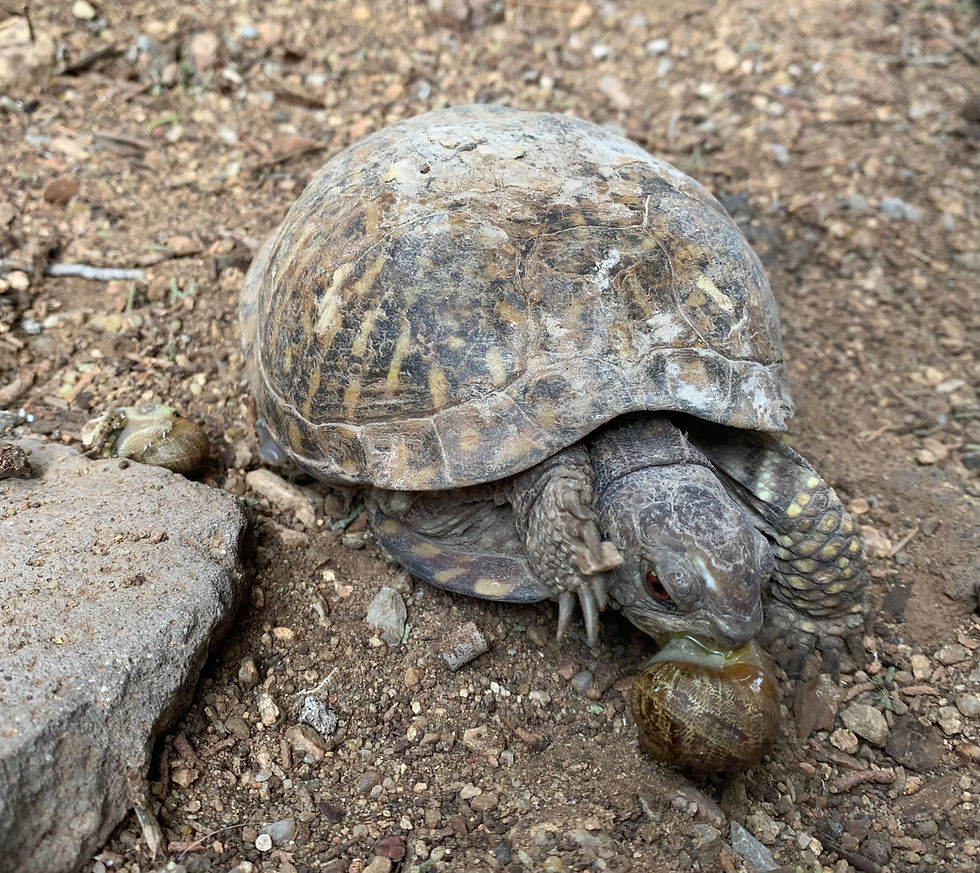Mental Carapace
- Tayo Basquiat
- May 8, 2024
- 4 min read

This is one of several turtles who live in my friend Claudia's yard. If I had turtles in my yard, I'd have a tough time leaving home. As with fish, I could just watch them do what they do for hours. Turtles are like these little prehistoric beings among us. So dang cool, even if I did feel bad for this snail the turtle rather violently dispatched.
The turtle encounter reminded me of something I read in Desierto by Charles Bowden, one of my favorite authors. He describes the illegal harvesting of sea turtles in Mexico:
“The harpoon slams down, the big barbed tip drives through the carapace, and a green turtle is pulled to the surface, boated, and lies at my feet thrashing frantically with its flippers. The black eye, about the size of a Ping Pong ball, stares out, the long flippers keep searching for the ocean as they scrape against the fiberglass hull. I cannot bear the sound of that scraping.” (95)
Because his prose is so stellar, I feel as though I am there in that boat, and I, too, cannot bear the sound of that scraping. I cannot bear the cruelty of the harpooners. We can argue about this just being the cycle of nature: turtle eats snail, human eats turtle, the turtle's shell no match for the harpoon, nor the snail's against the turtle's claws and snapping jaw, but I don't like it (and it's why I choose a plant-based diet).
In both cases, however, their respective carapaces did and do protect them from a lot, though. They'd be in a sorry situation without them, necessary gear from nature's armory.
Humans need a kind of carpace as well, a mental carapace. David Goggins in his memoir Can't Hurt Me chronicles his experiences of violence, racism and struggle throughout his life. He dealt with his father's physical abuse, a chaotic home life, racism, a learning disability, self-sabotage, and deprivation, and he pulls no punches in admitting how this made him full of an anger and rage for which he had no outlet and which led him down a bad path. The story of how he changed this, how he developed a mental armor that allowed him to find deep healing and peace and to accomplish some really astonishing things in his life, makes for an inspiring read, especially the audiobook version which includes discussions between Goggins and Adam Skolnick, the ghostwriter for the book, offering further insight into how he developed his mindset. His message: if he can do this, with all that he faced in his life, you and I can, too.
Life, says Goggins and I concur, is about mindset. Will the right mindset keep all the pain, threats, struggles at bay? Nope. Will the right mindset serve you well in the midst of those things? Absolutely. Too often we let pain or trauma, failures or struggles define us, a kind of victim mentality or self-pity that becomes an ongoing perpetuation of those inciting incidents. I'm not immune to this, but I also want to aggressively deal with that tendency when it arises. This is hard, hard work, emotionally and mentally. You have to face what has happened, understand the normal protective moves the mind tries to make--blame others, give up, withdraw, hide, don't trust, don't let people in, use substances to self-medicate, escape, etc., ad nauseam, the clever little mind--and then flip the switch that turns that experience into fuel. Layer by layer, one experience at a time, this builds the mental carapace, a toughness and resilience that comes from within instead of without. Soon, instead of saying, "I can't" and quitting, you prove that you can, even if it is hard, even if you still fail. Again, we don't control or pick what comes our way in life, even if we desperately try to exert that illusion of control. What we can control is how we respond to what comes our way. This is easier to write than to enact. To build a strong mental carapace, you have to embrace hard things, challenge yourself, be uncomfortable, face truths that you'd likely rather avoid.
Of course, not everyone chooses this path, refuse to build up that mental carapace. They choose to let life have it's way with them, let others define who they are and what they are capable of. Many give up or just never manifest what's really within them. Knowing as I do everyone who is reading this blog at this point, that you are my friends and people I care about, I cannot bear this for you. Boated, imprisoned, death in life before physical death. Metaphorically, it's like that sea turtle's flipper searching for the freedom of the ocean, the sound of that flipper scraping the hull. I don't want that life for you, for me.
Another feature of Goggins' book is ten tasks/missions or exercises designed to let readers practice building their mindset and changing old patterns of thought and behavior. I'll leave you with one of them (though I recommend reading the whole book) as an actionable way you can start building your mental carapace today.
Task: Write in your journal all of the things you don’t like to do and the things that make you feel uncomfortable. Do one of them every day.
Mission: Do something that sucks every day, slowly creating a more productive, can-do mentality when encountering stressful situations. This is how you callous your mind.






Comments